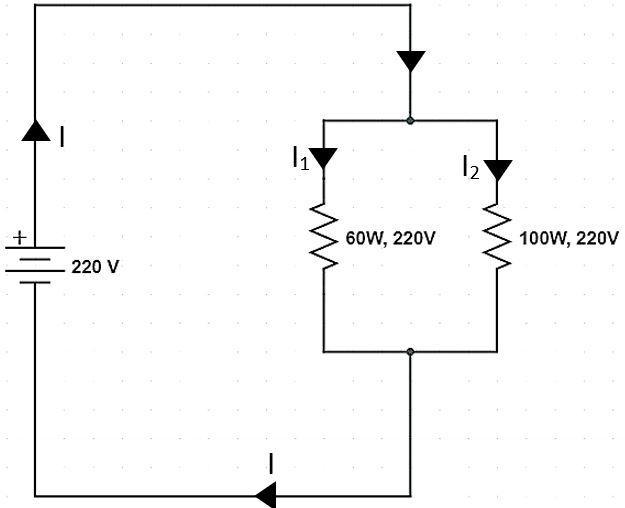
Answer
452.4k+ views
Hint: The two lamps have been connected in parallel and their power ratings and voltages have been given. We can first calculate the current in each of the lamps by using the power formula. Then, the required result will be the sum of the two currents in each lamp.
Complete step by step solution:

Let us assume the power of one lamp be $P_1$ and that of the second one be $P_2$.
It has been given that the voltage at the supply and in both the lamps is, say V=220V.
Therefore, using the formula of power, $P=VI$, where V is the voltage supplied and I is the current.
Therefore, current passing through the first lamp, $I_1 = \dfrac{P_1}{V}=\dfrac{100}{220}=\dfrac{5}{11}A$
Similarly, current passing through the second lamp, $I_2 =\dfrac{P_2}{V}=\dfrac{60}{220}=\dfrac{3}{11}A$
According to the questions, the lamps are connected in parallel, that means the current drawn through the supply will get divided in the two lamps.
So, net current, $I={I_1}+{I_2}=\dfrac{5}{11}+\dfrac{3}{11}=\dfrac{8}{11}=0.73A$
Hence, the net current drawn through the supply is 0.73 A.
Additional information:
In a circuit, when two distinct resistances are connected in series, the current remains the same while the voltage varies. But, when the same resistors are connected in parallel, the voltage remains the same, while the current gets distributed.
When two resistors are connected in parallel, the overall resistance of the circuit decreases. And that is why, in our homes, the electrical appliances are usually connected in parallel with the main supply to reduce the overall resistance and thus reduce the power loss.
Note: As the lamps were connected in parallel and are of different ratings, the current will be distributed unequally and the potential difference or voltage will remain same in each of the lamps while the currents would have been same, if they were connected in series.
Complete step by step solution:

Let us assume the power of one lamp be $P_1$ and that of the second one be $P_2$.
It has been given that the voltage at the supply and in both the lamps is, say V=220V.
Therefore, using the formula of power, $P=VI$, where V is the voltage supplied and I is the current.
Therefore, current passing through the first lamp, $I_1 = \dfrac{P_1}{V}=\dfrac{100}{220}=\dfrac{5}{11}A$
Similarly, current passing through the second lamp, $I_2 =\dfrac{P_2}{V}=\dfrac{60}{220}=\dfrac{3}{11}A$
According to the questions, the lamps are connected in parallel, that means the current drawn through the supply will get divided in the two lamps.
So, net current, $I={I_1}+{I_2}=\dfrac{5}{11}+\dfrac{3}{11}=\dfrac{8}{11}=0.73A$
Hence, the net current drawn through the supply is 0.73 A.
Additional information:
In a circuit, when two distinct resistances are connected in series, the current remains the same while the voltage varies. But, when the same resistors are connected in parallel, the voltage remains the same, while the current gets distributed.
When two resistors are connected in parallel, the overall resistance of the circuit decreases. And that is why, in our homes, the electrical appliances are usually connected in parallel with the main supply to reduce the overall resistance and thus reduce the power loss.
Note: As the lamps were connected in parallel and are of different ratings, the current will be distributed unequally and the potential difference or voltage will remain same in each of the lamps while the currents would have been same, if they were connected in series.
Recently Updated Pages
How many sigma and pi bonds are present in HCequiv class 11 chemistry CBSE

Mark and label the given geoinformation on the outline class 11 social science CBSE

When people say No pun intended what does that mea class 8 english CBSE

Name the states which share their boundary with Indias class 9 social science CBSE

Give an account of the Northern Plains of India class 9 social science CBSE

Change the following sentences into negative and interrogative class 10 english CBSE

Trending doubts
Difference between Prokaryotic cell and Eukaryotic class 11 biology CBSE

Which are the Top 10 Largest Countries of the World?

Differentiate between homogeneous and heterogeneous class 12 chemistry CBSE

Fill the blanks with the suitable prepositions 1 The class 9 english CBSE

Difference Between Plant Cell and Animal Cell

Give 10 examples for herbs , shrubs , climbers , creepers

The Equation xxx + 2 is Satisfied when x is Equal to Class 10 Maths

Write a letter to the principal requesting him to grant class 10 english CBSE

Change the following sentences into negative and interrogative class 10 english CBSE



